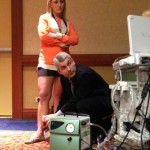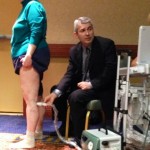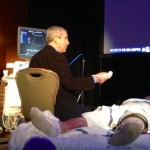The primary goal of a rapid cuff inflator is to take the unnecessary stress out of venous insufficiency studies. While the machine is fairly straightforward to use, we at ACI Medical are always looking for ways to perfect the experience for vascular sonographers.
The VenaPulse® Hands-Free Augmentation Device will give sonographers standardized augmentations. However, it is up to the sonographer to know what works best for each patient’s unique physiology and medical condition.
With this simple guide, it is our hope that sonographers will be able to increase efficiency in the exam room. We will start at the beginning, when a patient is seen and studied for the first time.
1. Matching Cuffs to Patients
The first and most important step for cutting down on exam time is to decide which cuff is best for the patient walking through the door. Is the patient’s frame small, medium or large? Which valves do you need to study? How will the patient be positioned throughout the exam? Here are short profiles on the two types of inflation cuff provided in your VenaPulse® unit:
The Blue Cuff

Technologists have the option of placing a rapid inflation cuff anywhere along the patient’s leg.
- Widely used for any patient regardless of size
- Wraps anywhere from above the ankle to the upper thigh
- For use in any patient position
- Allows sonographer to visualize valves up to and including the sapheno-femoral junction
Also included with each VenaPulse® device is a black foot inflation cuff. This cuff does what the blue inflation cuff can’t: it allows you to study vessels just above the ankle.
The Black Foot Cuff

Using the foot inflation cuff allows you to see perforators in the lower leg.
- Best used to view perforators and valves in patients with normal- to large-sized feet
- Ideal when patient is in relaxed reverse Trendelenburg position or standing with all weight on the non-studied leg
- *Augmenting smaller feet may not produce adequate results due to lack of blood volume
2. Consider the Refill Time
Consider this: the average rate for arterial blood to flow back into the legs and feet is about 1.8 mL/second in a normal person and there are about 20 cc’s of blood in the foot. When the augmented area is full of blood, you will get a nice visual in the veins. However, if you do not wait long enough for the leg/foot to refill, you may get an unsatisfactory result.
We recommend waiting at least 15 to 20 seconds between augmentations to allow the patient’s blood to fill the area once again.
3. The VenaPulse® Device is Key to Charting
Your vascular lab can help minimize the variation between studies by using a rapid cuff inflator instead of hands. Even if the same patient sees two different sonographers, you can all be confident that each augmentation performed during other exams was the same as every other.
Just take note of the pressure used and you’re all set!
4. Take Care of Yourself During Every Exam

Using a foot-operated rapid cuff inflator helps you avoid hand cramps.
All people have their physical limits, and sonographers are no exception. During a long exam, does your hand begin to cramp? How does your back feel after an hour and a half of repetitive bending and twisting?
Having a foot-operated rapid cuff inflator will certainly help you be more comfortable so you can focus on the task at hand.
Mint Medical Education also has a great article about how sonographers can survive venous insufficiency exams and make the lab more ergonomically friendly.
.jpg)



























